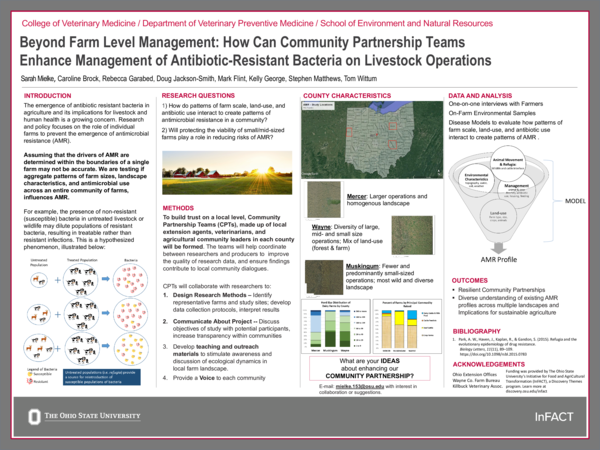Academia.edu no longer supports Internet Explorer.
To browse Academia.edu and the wider internet faster and more securely, please take a few seconds to upgrade your browser.
Beyond Farm Level Management: How can Community Partnership Teams Enhance Management of Antibiotic-Resistant Bacteria on Livestock Operations
Beyond Farm Level Management: How can Community Partnership Teams Enhance Management of Antibiotic-Resistant Bacteria on Livestock Operations
2019, Ohio State University. Office of Outreach and Engagement
Related Papers
Journal of Dairy Science
A participatory, farmer-led approach to changing practices around antimicrobial use on UK farms2021 •
2019 •
The research reported here uses resilience thinking in examin-ing farmer responses to disturbance scenarios in the North Puget Sound region of Washington State. Through farmer resilience workshops based on plausible disturbance scenarios of climate change, seasonal flooding, energy price spikes, and rapid urban-ization, farmers identified further threats to farm systems, possible thresholds of undesirable change in farm systems, and adaptive strategies useful in addressing the examined threats. It is clear that adaptive strategies become more complex at scales beyond the farm level. Further, individual commitment to a rural, farm lifestyle was an important component of whether a farm operation would thrive within larger nested systems. At the same time, farmers in the study recognized the need to re-frame agricultural policy in the United States away from emphasis on the stabilization of prices, and more towards farmer autonomy within agreed-upon guidelines.
2021 •
As part of the European project H2020 DYNAVERSITY (1) (Dynamic seed networks for managing European Diversity), a study on the potential of Community Supported Agriculture (CSA) for on farm management of cultivated biodiversity was conducted by INRAE and URGENCI. CSA can be defined as a direct partnership based on the human relationship between people and one or more producers who share risks, responsibilities and benefits of agriculture through a binding long term agreement. This study led to the publication of a report about the issue of raising consumer awareness about agrobiodiversity challenges in the context of the CSA partnerships (2), which draws recommendations to foster more involvement from the CSA movement into the issue of on farm management of cultivated biodiversity. We will be presenting our results, thoughts and recommendations in the framework of the theme 4 “Innovation Organic Farming”, in order to promote CSAs as a social innovation for on farm management of culti...
2020 •
Journal of Sustainable Agriculture
Moving Beyond the Dilemma: Practices that Contribute to the On-Farm Management of Agrobiodiversity2012 •
Frontiers in Veterinary Science
Editorial: Interdisciplinary approaches to antimicrobial use in livestock farmingJournal of Agriculture, Food Systems, and Community Development
A collaborative approach to COVID-19 response: The Center for Environmental Farming Systems community-based food system initiatives2021 •
The Center for Environmental Farming Systems (CEFS) has spent the past two decades developing local food systems to support communities and increase resilience. The COVID-19 pandemic has shown how existing structural inequities, primarily along racial lines, are exacerbated. It has also shown the value of community-based food systems work that helps communities network, sharing valuable resources and funding to respond to the ongoing crisis. In this article, we document how CEFS’ community-based food systems initiatives are responding to the pandemic. Some of CEFS programs are community-based, working with food policy councils, offering racial equity trainings, networking schools and early care and education sites, and supporting youth convenings and internships. Others are focused on production and supply chains for meat, seafood, and produce in order to develop stronger local food systems. Throughout the work of all of CEFS’ community-based food systems initiatives in response to...
Durnovo N.N. Manuscrits russes distinguant l’ancien о “acute” et l’o d’une autre origine / Nicolas Durnovo. – [Helsinki, 1932]. – P. 7–13. – Отдельный оттиск из: Annales Academiae Scientiarum Fennicae. Ser. B, nid. 27.
N.N. Durnovo. Manuscrits russes distinguant l’ancien о “acute” et l’o d’une autre origineВероятно, оттиск принадлежал Д.Н. Ушакову.
RELATED PAPERS
2024 •
2023 •
Confluenze. Rivista Di Studi Iberoamericani
Imágenes del golpe de Estado chileno en medios extranjeros: narrativas visuales entre el 12 de septiembre y el 17 de octubre del año 19732023 •
Pontes e Viadutos Rodoviários com Tabuleiros Pré-Fabricados na BR-381 e na BR-101 (Brasil) Conceção, Projeto e Obra
Pontes e Viadutos Rodoviários com Tabuleiros Pré-Fabricados na BR-381 e na BR-101 (Brasil) Conceção, Projeto e Obra2020 •
Journal of Applied Physics
Nanoshells as a high-pressure gauge analyzed to 200 GPa2011 •
2021 •
Estudos Avançados
Governança da água na Região Metropolitana de São Paulo - desafios à luz das mudanças climáticas2021 •
International Journal of Rock Mechanics and Mining Sciences
Atypical evolution of seismicity patterns resulting from the coupled natural, human-induced and coseismic stresses in a longwall coal mining environment2016 •
Applied Entomology and Zoology
Estimation of abundance and dispersal distance of the sugarcane click beetle Melanotus sakishimensis Ohira (Coleoptera: Elateridae) on Kurima Island, Okinawa, by mark-recapture experiments2008 •
Journal of Plant Nutrition
Short-Term Effect of Drought and Salinity on Growth and Mineral Elements in Wheat Seedlings2006 •
Történelem – társadalom – vidék : Jubileumi tanulmánykötet II.
A magyar fiatalok külföldi mobilitási tervei2022 •
Imam Zayd Institute
Was 'Alī b. Abī Ṭālib Appointed as the Political Leader (Caliph) After the Prophet?2024 •
